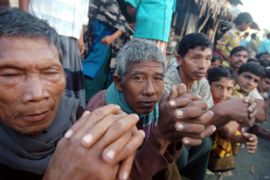Disease deaths in Bangladesh
Diarrhoea cases reported as cyclone survivors await food, fresh water and shelter.

|
Your Views |
|
“Tragedies like this happen quickly and take so much time to recover” Rezasantorini, Chicago |
Some 241 people have been buried and more than 500 are still missing, feared dead, according to Jahandir Alam, a local government official.
“The last six days we spent cooking rotten rice,” Abdul Gafur, a resident, said.
“[Until now] we have not received any aid from anyone. No boat came to us as most of them had been damaged or washed away.”
Ripon Molla, a fisherman, said: “Even our market which before was full of food items has been wiped out.”
‘National calamity’
In a televised speech on Tuesday, Fakhruddin Ahmed, Bangladesh’s interim leader, described the cyclone as “a national calamity” and urged citizens to help the affected people.
Ahmed said: “The destruction of houses, roads, trees and crops by the hurricane is unimaginable.”
| In Video |
|
– Aid agencies struggle to reach cyclone victims |
Menwhile, the government said international aid worth about $120 million had so far been promised.
General Moeen Ahmed, the head of the army, tried to reassure villagers that aid was on its way during a visit to some of the worst affected areas.
“Not a single man shall die without food as the government has sufficient stock of foodstuffs,” he said.
He pledged to set up a “floating hospital” to provide urgent medical treatment, including surgery.
The death toll stands at least 3,500, but officials say that many people were missing and that the number was expected to rise.
It is feared that the final toll could be between 5,000 and 10,000.
The UN Children’s Fund (Unicef), estimated that nearly half of those affected by the disaster were children, an estimated 400,000 of them under the age of five.
Significant damage
Douglas Casson Coutts, the World Food Programme representative for Bangladesh, said the extent of the devastation would make it difficult for people to rebuild their lives.
“There is significant damage to the infrastructure. There will definitely have to be longer term assistance to get people on their feet again,” he said.
